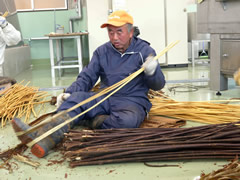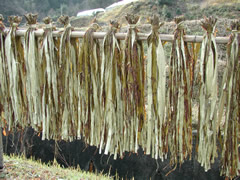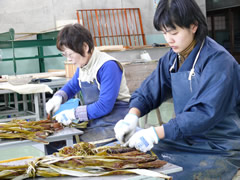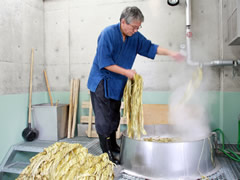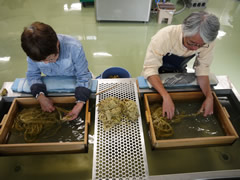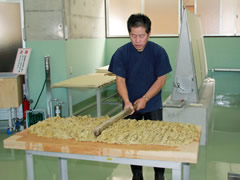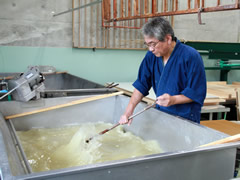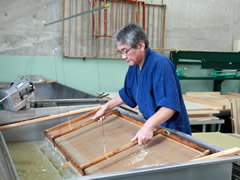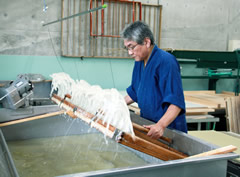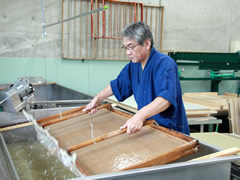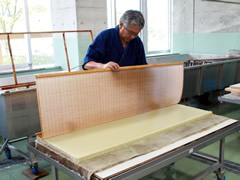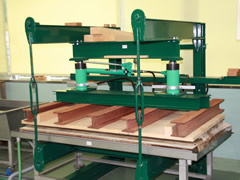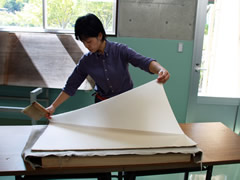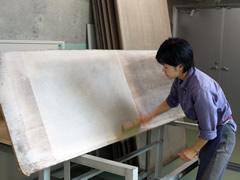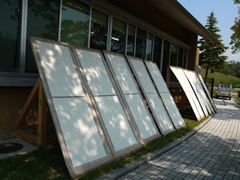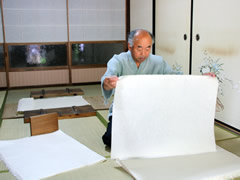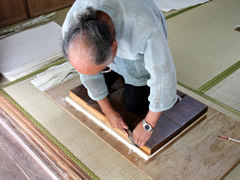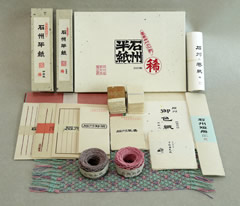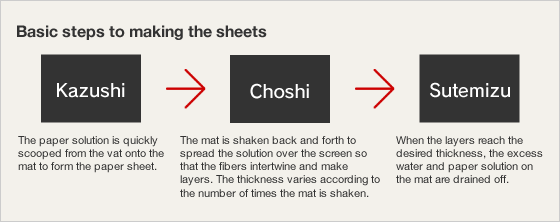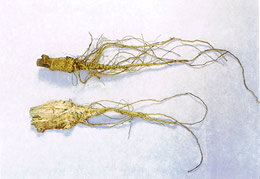SEKISYU WASHI Production Process video.
How to make Sekishu Washi
1. Cultivating bushes (kozo) for raw materials
The raw materials for Sekishu washi are kozo, mitsumata, and gampi shrubs. Kozo and mitsumata are cultivated in the region but gampi grows wild. Sekishu-banshi made from Sekishu’s kozo is well known as the strongest washi paper in Japan.
2. Harvesting raw materials
Branches from the shrubs are usually harvested from December to January. The branches are cut off at an angle with a sickle.
3. Steaming branches (kozo mushi)
The branches are steamed in a process called seiromushi, which can be easily done by a few people. Seiromushi makes it easy to strip the branches of their bark.
4. Stripping the bark (kawa hagi)
The branch is held in one hand and the bark in the other, and then both are wedged between the feet so that the bark can be stripped from the branches in such a way that the stripped bark makes a cylinder shape.
5. Drying black bark
The stripped black bark is tied up in bundles to be dried in the wind. After drying well, the bark is stored.
6. Scraping black bark (sozori)
After the black bark is softened in water, each bark piece is put on a stand and its outer layer is carefully scraped off with a knife. When using kozo, to heighten the quality, the epidermis is left between the outer layer and the inner layer.
7. Washing (suisen)
The scraped white bark is washed by clear water to remove all impurities.
8. Boiling (shajuku)
The bark is unbundled and boiled in a large caldron containing a 12% alkali solution. While boiling, the bark is turned every 30 minutes for about 2 hours so that they can be boiled evenly. And then the bark is steamed.
9. Removing impurities (chiri tori)
The boiled bark strips are inspected one by one and all impurities are carefully removed by hands in clear water. When using kozo, the harshness is first removed before doing the above procedure.
10. Beating (kohkai)
The bark is beaten with an oak stick to loosen the individual fibers. In the original Sekishu method, the bark is beaten 6 times from right to left and back, turned over and beaten again. It is turned over 6 times in total.
11. Making the sheets (kamisuki)
Water, a paper solution, and tororo-aoi are combined in a sukibune, or paper-making vat, and evenly mixed with a bamboo stick. Three steps are then taken, called kazushi, choshi, and sutemizu, to make Sekishu-washi.
12. Kazushi
The paper solution is quickly scooped from the vat onto the mat.
13. Choshi
The mat is shaken back and forth to spread the solution evenly over the screen, to entwine the fibers and make layers. The thickness varies according to the number of times the mat has been shaken.
14. Sutemizu
Draining off the water. When the layers have the desired thickness, the excess water and paper solution are drained off from the mat.
15. Moving sheets to paper beds (shito utsushi)
After the water has been drained off, the washi sheets are moved to paper beds. The sheets are piled one by one onto paper beds. Approximately 250 sheets of paper are made in a day.
16. Pressing out water (assaku)
After leaving the sheets on paper beds overnight, weights are added to press out the remaining water.
17. Stripping (shito hagashi)
When the water has been pressed out, the sheets are separated one by one.
18. Brushing (hoshiita hari)
The damp sheets are brushed onto wide boards.
19. Drying (kansoh)
The sheets are sun-dried outdoors. While the washi is drying, it acquires its proper stiffness and beautiful appearance.
20. Selection (senbetsu)
After the sheets have dried, they are carefully inspected. Any sheet with tears, holes, shrinkage, a bad surface, or an uneven thickness is rejected.
21. Cutting
Washi that has been chosen in the final selection process is cut to make various paper products.
22. Sekishu Washi
Using washi made from kozo, mitsumata, and gampi, various types of paper and products are made, including Sekishu-banshi, an Important Intangible Cultural Heritage. Other products include Japanese painting and calligraphy paper, certificate paper, paper for dyed products, envelopes, stationery, postcards, business cards, colored paper, notebooks, and traditional Japanese letter paper.
Papermaking
Water, a paper solution, and tororo-aoi are combined in a sukibune, or paper-making vat, and evenly mixed with a bamboo stick. Three steps are then taken, called kazushi, choshi, and sutemizu, to make Sekishu-washi.
Tororo-aoi (Aibika plants)
(Binomial name: Abelmoschus manihot Medik)
This is used as a supplement for washi made according to the Nagashi-suki method. The tororo-aoi root is crushed, yielding a substance called neri. When neri is added to water and paper solution in a vat, it helps to evenly distribute the bark fibers. In the papermaking process, neri works to bind the fibers together. Since it is not sticky, the individual layers of paper can be pulled apart during the drying process.



